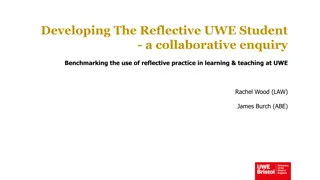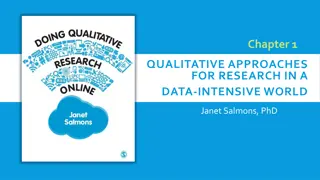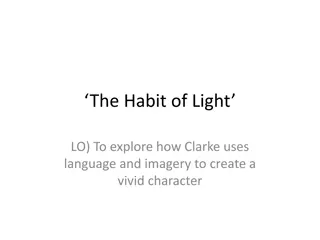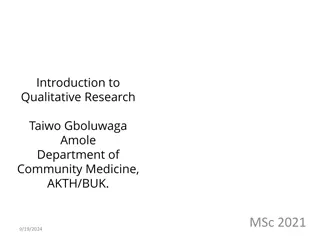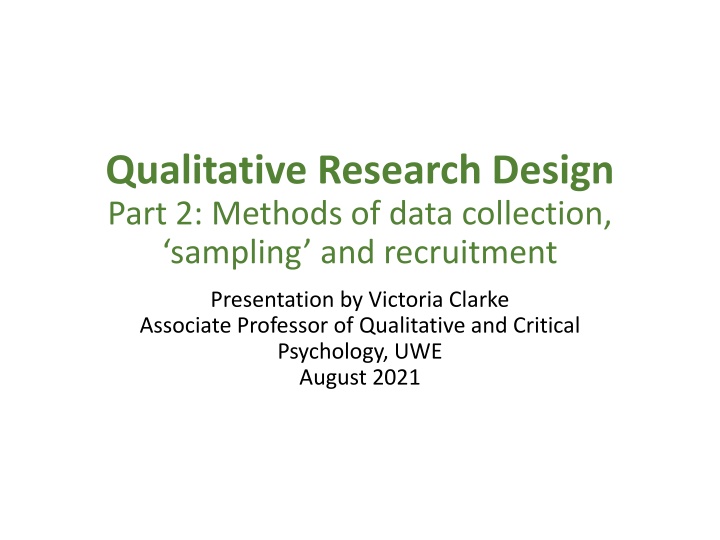
Understanding Qualitative Research Design Methods
Explore the intricate world of qualitative research design methods, including data collection, sampling, and recruitment. Get insights from Professor Victoria Clarke on the considerations that shape qualitative research design and learn about different data collection techniques. Dive into the nuances of research questions, methodologies, and ethical analysis in this comprehensive presentation.
Download Presentation

Please find below an Image/Link to download the presentation.
The content on the website is provided AS IS for your information and personal use only. It may not be sold, licensed, or shared on other websites without obtaining consent from the author. If you encounter any issues during the download, it is possible that the publisher has removed the file from their server.
You are allowed to download the files provided on this website for personal or commercial use, subject to the condition that they are used lawfully. All files are the property of their respective owners.
The content on the website is provided AS IS for your information and personal use only. It may not be sold, licensed, or shared on other websites without obtaining consent from the author.
E N D
Presentation Transcript
Qualitative Research Design Part 2: Methods of data collection, sampling and recruitment Presentation by Victoria Clarke Associate Professor of Qualitative and Critical Psychology, UWE August 2021
PowerPoint slides from the Braun, Clarke & Hayfield Qualitative Methods Online Teaching & Learning Resources Collaboration (QMOTLRC) Image of a white woman - Virginia Braun - a head and shoulders shot, she is wearing a red and white striped long sleeved top and glasses, and has her hands resting on either side of her face
Topic overview oUnderstanding the different considerations that inform qualitative research design oUnderstanding what constitutes robust and coherent qualitative research design oThere are a series of optional pauses for reflection throughout the lectures you can pause the audio- lecture and work through the questions on the slide. The various pauses for reflection will take you through the process of designing a qualitative study (and help you to reflect on the extent of your existing knowledge of the range and diversity of qualitative methods and to identify areas where you need to learn more).
Lecture overview oPart 1: Design principles and research questions oPart 2: Methods of data collection, sampling and recruitment oPart 3: Data analysis and ethics
Pause for reflection 1 Reflecting on a research question suitable for a qualitative project, identify possible appropriate methods of data collection, and decide which one is the most appropriate. Why is your chosen method the most appropriate? What strengths (and limitations) does it have in relation to other potentially suitable methods? Is there a good fit between your research question, methodology and method of data collection?
Data collection methods almost boundless possibilities! Interactive methods Even just with interviews, there are almost boundless possibilities: Face-to-face or virtual (telephone, video-calling, email, instant messenger ). Seated or walking and talking . Quiet room or specific setting (e.g. wardrobe interviews). Just talking or talking + stimulus materials (e.g. drawing task, photo-methodology, diary, vignette ). Solo or joint interviews (e.g. couple interviews). Focus groups Face-to-face or virtual (telephone or video conferencing, forums, multi-user domains [MUDs] ). Just talking or talking + stimulus materials or task (e.g. viewing media items, card sorting task ).
Other ways of capturing self-report data (more or less interactive) Qualitative surveys - online or hard copy, textual or visual data collection. Vignettes (hypothetical scenario + questions). Researcher directed/solicited diaries - more or less structured, textual/voice or multi-modal data collection, hard copy or virtual. Creative and visual methods photo- methodology, story completion (first person) Participatory methods memory work, action research User-generated online content - blogs, vlogs, forums
Data collection that moves beyond self- report oThird person story completion. oSecondary sources newspaper articles, advertising (non- interactive). oEthnography, field research and observation. oEndless combinations: Diary- interview method, vignettes used as elicitation tools or stimulus materials in interviews or focus groups
Pause for reflection 2 Having identified a wide-range of the possibilities for qualitative data collection, are there other methods suitable for use in your study?
Pause for reflection 3 You have determined a research question and data collection method for your study, now consider your sample or dataset/participant group. You can sample participants and data items (e.g. secondary sources). How many people/data items do you intend to select? Why this many? Who/what will (and won t) be eligible to participate in your research? Why this group of people/data items (and not others)? Are there any potential limitations of your proposed dataset? (e.g. the usual suspects ) How will you access/recruit your participants/data items? Will you need to advertise your research? Where will you recruit participants/find data items? What challenges, if any, will you face in accessing/recruiting your participants/data items?
'Sampling' in qualitative research: Size of dataset o The size of the dataset/participant group needs to be appropriate to research question and provide an adequate amount of data. o Typically smaller samples than in quantitative research, but there are no hard and fast rules for the size of the dataset/participant group in qualitative research. o The size of the dataset/participant group is shaped by many factors, including some that can t be determined in advance: what you want to know, the purpose of the inquiry, what s at stake, what will be useful, what will have credibility, and what can be done with available time and resources (Patton, 2002: 244). the quality of the data, the scope of the study, the nature of the topic, the amount of useful information obtained from each participant, the numbers of interview per participant ... And the qualitative method and study design used (Morse, 2000: 3).
Is saturation a useful way to determine the size of the dataset? One widely used but often misunderstood and theoretically delimited sample size criteria: saturation. Often treated as an unquestioned gold standard for sample size. Originally conceived of as theoretical saturation in grounded theory with concurrent process of data collection and data analysis. Saturation is acknowledged as an unfortunate metaphor (Dey, 1999: 257) and was arguably never intended to mean knowing it all. Now more widely understood as data saturation - information redundancy (Morse, 1995). Also code, theme and meaning saturation the latter requires more data to achieve (Hennink et al., 2017).
Problems with saturation Saturation as information redundancy is often mentioned but rarely defined and how it was determined is rarely discussed. It is not theoretically consistent with all forms of qualitative enquiry (see Braun & Clarke, 2019). Delimiting assumptions can include: Interpretation is finite it is possible to know it all. Meaning resides in data awaiting discovery by the researcher. Saturation can be determined in advance of data analysis (e.g. based on the researcher s impressions of the data during data collection).
Alternatives to saturation Alternative concepts centre meaning richness. Theoretical sufficiency (Dey, 1999) captures the notion that data collection stops when the researcher has reached a sufficient or adequate depth of understanding. Information power (Malterud et al., 2016) - the researcher reflects on the information richness of the dataset and how that meshes with the aims and requirements of the study.
Information power (Malterud et al., 2016) A study with: o A broad aim; o Non-specific or few particular inclusion criteria; o A more inductive (and exploratory) approach; o Thinner data generated from each participant or data item; o Analysis focused across a dataset; and o Analysis conducted by a novice researcher would generally require a larger participant group/dataset to have adequate information power that is, to be able to say something (qualitatively) meaningful. Such aspects should not be seen as operating independently and summatively, but as potentially interacting (Sim et al., 2018).
Strategies for generating datasets o Qualitative sampling tends to be purposive/purposeful - o Convenience sampling . o Snowball sampling/friendship pyramiding. o Stratification. o Theoretical sampling . o Maximum heterogeneity/variation sampling . o Homogenous sampling . When qualitative researchers decide to seek out people because of their age or sex or race, it is because they consider them to be good sources of information that will advance them toward an analytic goal and not because they wish to generalise to other persons of similar age, sex, or race. That is, a demographic variable, such as sex, becomes an analytic variable; persons of one or the other sex are selected for a study because, by virtue of their sex, they can provide certain kinds of information (Sandelowski, 1995: 180).
Recruitment challenges o The usual suspects . oHidden populations. oVulnerable groups. o Hard-to-engage populations. o Hard-to-reach populations. oBeing an insider or outsider researcher.
The practicalities of recruitment o Participants need to be informed about the research advertise the study in some way. o Calls for participants need to be engaging, informative (but not too detailed), and provide contacts for more information. o There are lots of potential recruitment sites: Key contacts (e.g. a support group facilitator). Groups and organisations on and off line (e.g. charities, youth groups, student clubs/societies, Facebook groups). Specific sites/locations (e.g. doctors surgeries, register offices). Newsletters, email lists and websites. Social media (e.g. Twitter, Facebook). Big events (e.g. LGBT+ pride events, wedding fairs). o Active recruitment generally more effective than passive. o Compensation?
References for part 2 Braun, V., & Clarke, V. (2021). To saturate or not to saturate? Questioning data saturation as a useful concept for thematic analysis and sample-size rationales. Qualitative Research in Sport, Exercise & Health, 13(2), 201-216. Dey I. (1999). Grounding grounded theory. Academic Press. Hennink, M. M., Kaiser, B. N., & Marconi, V. C. (2017). Code saturation versus meaning saturation: How many interviews are enough? Qualitative Health Research, 27(4), 591-608. Malterud, K., Siersma, V. K., & Guassora, A. D. (2016). Sample size in qualitative interview studies: Guided by information power. Qualitative Health Research, 26(13), 1753-1760. Morse, J. M. (2000). Determining Sample Size. Qualitative Health Research, 10(1), 3-5.
References for part 2 continued Morse, J. M. (1995). The significance of saturation. Qualitative Health Research, 5(2), 147-149. Patton, M. Q. (2002). Qualitative evaluation and research methods (3rd ed.). Sage. Sandelowski, M. (1995). Sample size in qualitative research. Research in Nursing & Health, 18(2), 179- 183. Sim, J., Saunders, B., Waterfield, J., & Kingstone, T. (2018). Can sample size in qualitative research be determined apriori? International Journal of Social Research Methodology, 21(5), 619-634.







